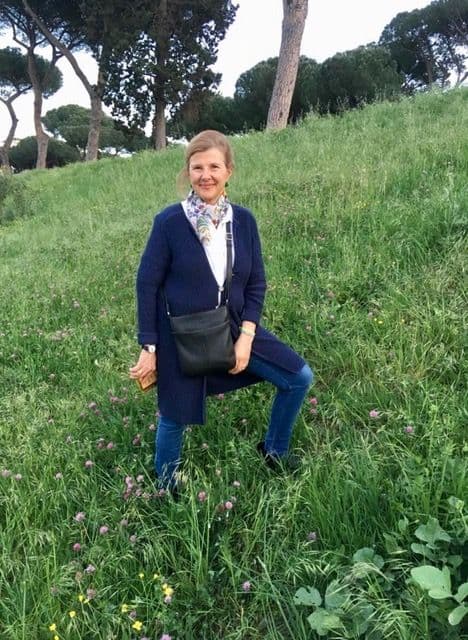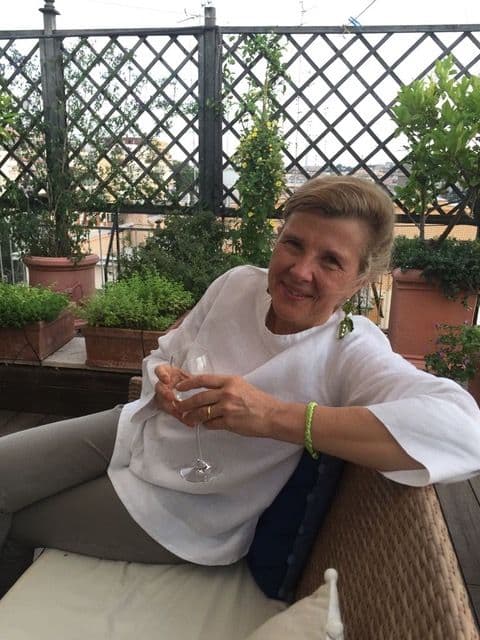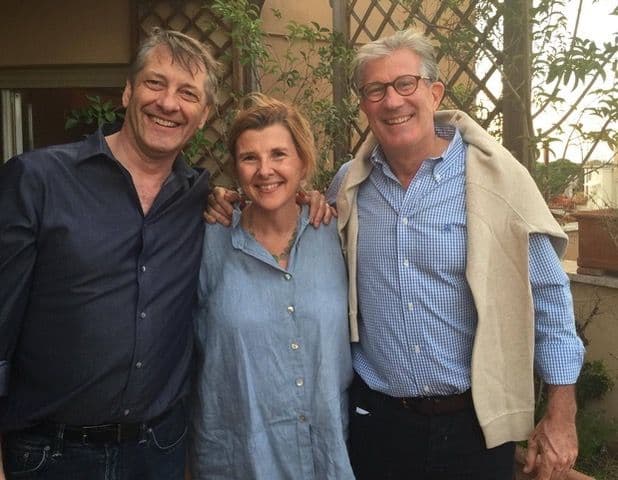OWNER, INSIDER’S ITALY

Through sheer good fortune, our family came to Rome in February of 1919 by virtue of a job offer accepted by my young grandfather as Assistant Commercial Attaché to the United States. From that day forward, the lives of my grandmother and the three generations to follow have been an endless swallow flight of being in Rome, leaving for short periods, and then coming back to our birthplace or the place that we feel most at home.
St Stephen’s was a lively, intellectual, multinational community of intensely closely knitted young people and deeply caring teachers. St Stephens between 1976 and 1980 still held some of the vestiges of the original school: somehow you could feel the shadow of Father Patterson; a sense that we were not far from that initial pioneering institution with a vision of a discernibly American prep school spirit on the Tiber with an intense commitment to liberal arts. Mr. Tooman, Head of School for the first two years I was there, and a practicing Episcopalian, always in jacket and tie, ended each Morning Meeting with a prayer. It was not lost on any of us, as we faced him in the Chapel, how we were an atypical congregation, with torn jeans, lots of wild hair, and a rich, wild desire to spring up and bolt to the Cortile bar for a coffee and for many, a cigarette.
It was impossible to be oblivious, in those intensely politically charged years with considerable political turmoil in Italy lasting from the late 1960s until the late 1980s, of the wave of both far-left and far-right incidents of political terrorism. I waded through heroin needles to get back to my home in Campo de Fiori. Tear gas was part of that period too, and lots of it, on Corso Vittorio and Largo Argentina and along the river.
All of us at St. Stephen’s in 1978 remember the kidnapping and assassination of Aldo Moro. We talked about all of this, teachers and students, and one of the characteristics of the period was the fraternization between teachers and students in the Cortile, which was the unquestionable center of the school. A continuous smoke haze rose here during intervallo and lunch, and after school. The cappuccino and the plum cake, and the panini served up by Italo fed conversation after conversation.
The teachers I had at St. Stephen’s were determinant and have left imprints for which I am forever grateful. I to this day sing tunelessly but daily the music that was so enthusiastically taught by Richard Trythall during four years of chorus, a repertoire from Palestrina to Hair ! to Josquin des Prez to Joni Mitchell. When I see Richard Trythall whenever I am at the School, my heart jumps up because he is not changed. And so I am again a teenager too! Peter Rockwell and Jack Ullman and Tom Carpenter and Gareth Jenkins were central in my understanding that English, art history, and history were magnificent subjects worth digging deeply and fully into, and worth understanding. Reading Oriana Fallaci with Signora Miccone (then Locilento) was thrilling! The teacher’s intense enthusiasm made every class special and worthy. But all of the St. Stephen’s teachers I had were remarkable, accessible, willing, and involved; this extended to trips, which were anticipated with so much excitement for months and months, especially when a trip went to obscure places. It was difficult to impress a teacher enough to find yourself selected to be on it.
To see Greek temples – walking to many of them on foot -- with Tom Carpenter in Sicily was something not to be forgotten; to explore on train and foot the dense historical and cultural fabrics of Basilicata and Calabria and Abruzzo with Jack Ullman and a small group of students, sleeping in caves, in semi-abandoned monasteries, and often in 19th-century conditions. What a thrill and delight! We were entirely cut off from the world, meeting villagers and others who were of a pre-industrial Italy, all the while ferreting out exciting bits of history, art, and architecture.
To look at the Renaissance art that he loved with Peter Rockwell in Rome, Florence, Pistoia, and Lucca, and to hear, as we crowded close to some masterpiece, from his sculptor’s perspective exactly how a sculpture was carved; to share his excitement and his wonder! It was heady, and it was real, and it was the stuff of a St Stephen’s education.
I chose my U.S. university, Bryn Mawr, because two of my teachers had gone to its brother school, Haverford, and my college counselor had gone to Swarthmore. Bryn Mawr was wonderful, but especially in my freshman year, I longed for St. Stephen’s and went crazy in an environment where everyone spoke only English.
I pined for art history as it was taught at St. Stephen’s, certainly partially in the classroom but the substantive part in churches, museums, on the street. I craved weekly two hour field trips. I longed to connect academics with artifacts, with tangible remains, with things to look at.

After college, I longed for Italy, so I beat my way back and opened up Rome’s first chocolate chip cookie store in the Jewish Ghetto. In college, I had run an Italian cafè which was very fun, and I wanted to do something related to food, and at the time, there were no chocolate chip cookies. There was at the time a group of young Romans called “paninari,” with money in their pockets and wandering about looking to eat something. Usually that something was “panini'', but I thought: “why not cookies ?” - and opened up Rome’s first chocolate chip cookie store with a partner. I did that for a year-- it’s still there -- and during that period I thought to myself, “what will I do with my Bryn Mawr and St. Stephen’s education that’s a bit more intellectually satisfying?” And my thought was to recreate a business that I was running already as a summer job at St. Stephen’s but to do so on a more elaborate scale: gastronomic walking tours of Rome. I purchased a little red wagon, and I would stand outside luxury hotels and ask guests if they would like to go on gastronomic walking tours. To my delight, lots of people were interested.
I tried to recreate some of the wonderful walks I had taken at St. Stephen’s with my history and art history classes, and provide cogent historical and art historical commentary. In between, we’d stop at special food stores and pick up breads and cheeses, and pizza and wine, pastries, fruit, and so on and end up on the Aventine Hill, really the Parco degli Aranci, for a picnic.
As they lounged like Romans and Etruscans and ate, my clients would tell me where they were going next, and it was apparent that nobody was fully prepared for the next destination. This was 1986, no internet, no fax, just guidebooks, and I thought to myself, “here’s an interesting business opportunity,” so I began in ‘87--without any fanfare-- a company which became “Insider’s Italy”. In 1989, I officially registered the company and it was launched, requiring me to depart from Rome so as to be on the same continent as nearly all of my clients. I lived in the United States between ’89 and ’96, briefly in New Haven and for a longer period in New York City, in Brooklyn Heights, and the company took off. I would spend four months of each year in Italy researching, having fun, taking notes, observing, and thinking about the next season, and then I would return to New York and share everything I had discovered with the next lot of clients.
During those years, I became more interested in wine, especially Italian wines; all my friends were getting master’s degrees, and I thought, “I’ll get a Master’s in wine!” so I began taking classes in New York City to work towards an MW. In 1996, when it was clear the company was seaworthy, I realized I could come back to Europe. I wasn’t quite ready to return to Italy because I wanted to experience another part of Europe, so I chose England; moved to London and lived there between 1996 and 2001; continued studying wine and running the business, and eventually met my husband, Robert Stark, who was living in Amsterdam. The condition of marriage was that we would go back to Italy, so he left his job as a lawyer and joined me at Insider’s Italy. We moved back to Rome in January 2001. Our lives right now are divided between Rome and the Netherlands, where both of our children, Isabel and Nathan, are finishing high school.
I don’t have a Master’s in Wine yet, but I certainly still have an interest and I try to incorporate that passion and enthusiasm into my work. Italian wines largely resist the temptation towards homogenization of taste and standardization of sensory characteristics, and in my clients’ plans I often include bookings in vineyards and personal meetings with winemakers.

Of course, Rome is my favorite place on earth because in the unlikely situation that you tire of 2800 years of what’s above the surface, you start tunneling down into Rome’s underground archeology, or you look high up to terraces. If you’re truly lucky, you look up higher still and you’ll see one of those golden Roman skies full of swallows. If you’re bored with Rome, then there’s something wrong with you because it’s just the essence of everything that is extraordinary.
I love Pienza because it’s a perfect Renaissance humanist jewel of balance and harmony, sited in a landscape that touches me very deeply, full of delicious restaurants and interesting places to drink wine. I love Rovereto in the province of Trento which has a fascinating history, it’s the perfect size, is very progressive in the most important ways, cosmopolitan, and sited in a wide glacial valley surrounded by astonishingly high mountains.
My own travel preference has always been for Slow, unsuperficial travel, and for developing real relationships as I adventure.
But I have observed mass tourism at its worst in Italy, in Rome, in August, at the Colosseum; I have experienced Venice during the worst weeks of Carnival; I have observed onslaughts of walkers assaulting the Cinque Terre on a given day, and I have seen the mistakes which unknowingly clients can when they find themselves contributing to the destruction of places which are so delicate. From the beginning, I innately realized that Insider’s Italy clients have a mandate to travel responsibly as part of the enormous privilege of being in Italy.
COVID gives us the opportunity to think of how we can do “sustainable tourism” better. I always make a point of encouraging clients to select fewer destinations and explore them in greater depth. I consistently urge travelers to make use of our outstanding local scholars and docents who will ensure that our travelers are looking meaningfully at sights, art and architecture. I craft trips around visiting popular sites at off peak hours and always urge smaller destinations of extraordinary interest where you will have a piazza to yourselves. I draw in artisans, artists, small business owners, those who are out of larger commercial networks and make them part of our clients’ travel plans.
I have championed winter travel since the very earliest years of Insider’s Italy, and would urge those who love Italy to take advantage of travel this year in September, October, and all the way through until next spring. It’s a golden opportunity to enjoy major Italian destinations before the world rediscovers them. Our careful planning ensures that you are genuinely not only seeing things with sensitivity and sensibility but also taking advantage of a post pandemic window that may not present itself ever again.
A few years ago, I planned a trip for a classmate who represented why I delight in planning for St. Stephen’s alumni. They always have an innate love of Italy and an insatiable curiosity, and desire (remembering the St. Stephen’s Treasure Hunt and field trips and Trips!) to know what is beyond that hill, or that cypress tree, or in the next room of the museum. Alumni take enormous pleasure in bringing their families to Italy to show them the School and to share the Rome that they knew when they were here. This is such a moving thing, and our trips are easily built around that lovely experience. And they love to learn. It’s an enormous privilege to share Italy with travelers who love to learn. There is so much to learn in a country the size of California and with the diversity of an entire world. It’s impossible not to keep finding something new to see.
When you think about it, Italy’s geography is remarkable, offering Pantelleria (closer to Africa than it is to mainland Italy), extraordinary Alpine scenery in four regions; the highest number and density of both animal and plant species within the European Union; 23 national parks; three active volcanoes, and a staggering variety of regional foods and wines. In Italy you can move just a few kilometers and find changes in geography, architecture, dialect, cuisine, artisan production and climate. Geography opens and folds and contours and flattens. Italy holds an astounding 40% - 70% of the world’s art. A trip to Italy seems like numerous trips. Even France, twice Italy’s size, cannot offer such a remarkable variety on so many levels.
In truth, the goals I have set for myself were never particularly conscious except that primary one of ensuring that I would be ever connected to Italy. I’ve lived my life knowing -- both my parents and St. Stephen’s imprinted this on me -- that everything is worth looking at with care and attention. That listening well means avoiding distraction. And that those of us who were lucky enough to live in Italy, especially before the 1980s, need to take note of what we remember and what is now gone -- and ensure that we tell others, and leave a record, of what we saw, of the Italy we knew when we were at St. Stephen’s.
In terms of challenges, I always knew that as long as Italy was at the center of my life, everything would be fine. I had however to find a professional way of ensuring that it would be; I didn’t want to be like those who loved Italy at least as much as I did -- and then had left it. I had to find a way for my love to be my profession, and the only way I knew how to do that was to run my own Italy related business.
Turn off your phone for long periods. Celebrate the incredible friendships that you make at St. Stephen’s. They are friendships that will mark you for life and be with you forever. Look carefully, look deeply. And come back to Italy as often as you can.
The hours of talking in the Cortile would not have happened had we had phones. The fraternization between teachers and kids was just extraordinary. Every so often, our little world would be punctuated by Italo announcing he was turning off the coffee machine or Peter Rockwell would come out, and below, from a particular corner by the Chapel, “Art History!” because he was about to take off on an art history field trip, and the art history students would put down their cappuccino cups, and off they’d go. Then you’d hear, “Italiano!” because the Italian class was meeting in the garden. It was a humming forum of life before screens. We had no choice but to take advantage of these remarkable people with whom we had the privilege to spend four life changing years.
To learn more about Marjorie and Insider’s Italy, visit the Insider’s Italy website.